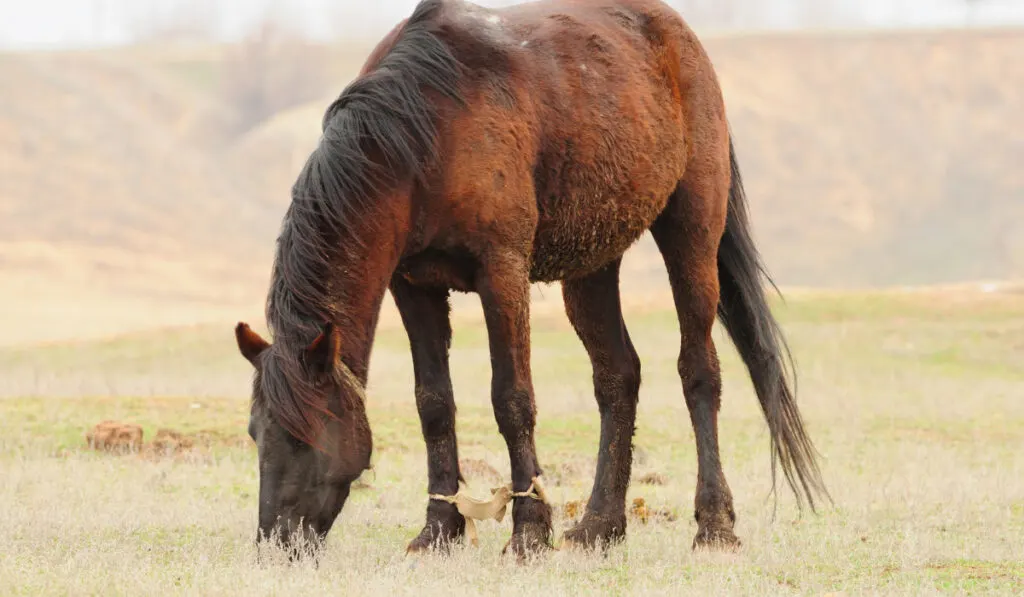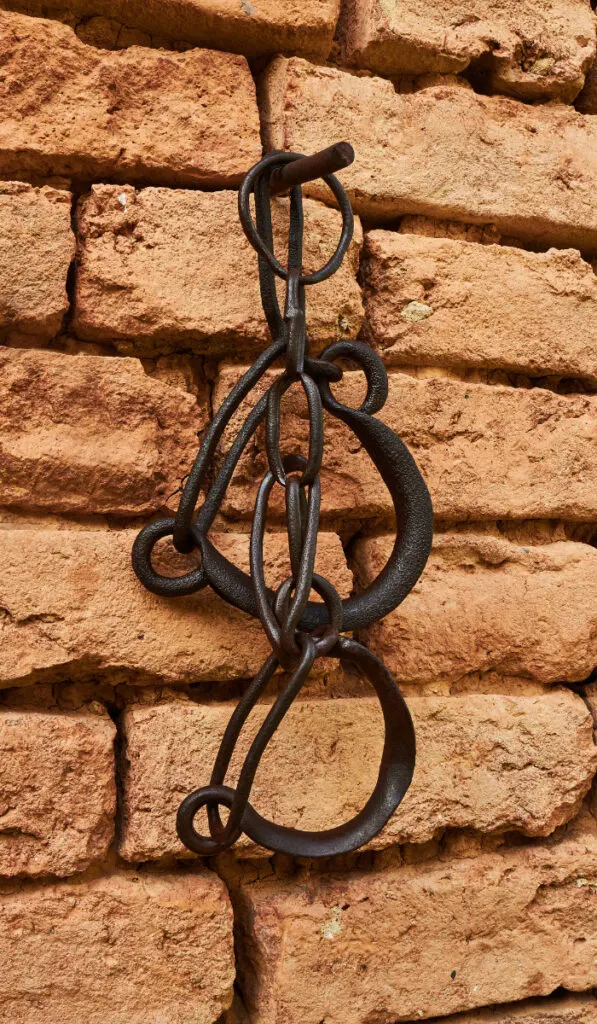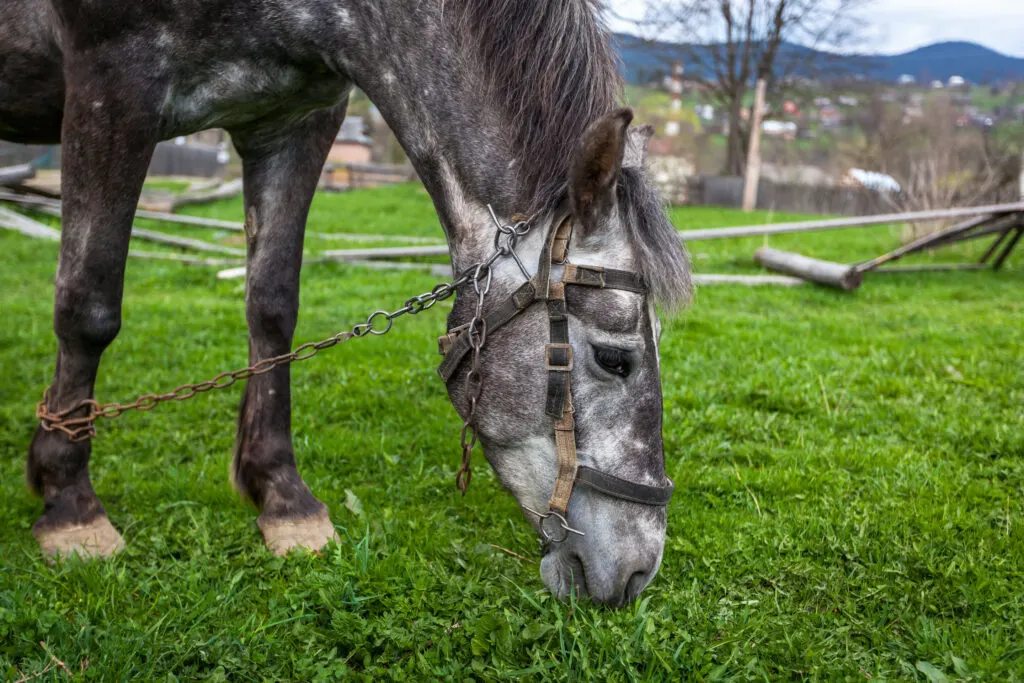To the casual observer, a hobbled horse can look strange – or even uncomfortable. But for an experienced handler and a well-trained horse, hobbles can be a useful tool in a trainer’s kit.

Hobbles are generally used for safety, whether they prevent a horse from bolting into a dangerous situation, or to teach a horse to remain calm and still during an emergency. There are many different kinds of hobbles, and each one has its own specific purpose and effect.
Table of Contents
What are Hobbles?
Hobbles are pieces of tack that essentially tie a horse’s legs together to restrict his movement. Some allow a horse to walk around, but others restrict his movement completely.
When used properly, hobbles can be effective safety tools that prevent horses from getting into sticky situations.
Historians have discovered evidence of hobbling horses that date back to ancient Egypt!
Disclaimer: Hobbles should only be utilized by those who have the proper education and experience. Horses with certain medical conditions or that have been sedated should generally not be hobbled.
With improper use, they can cause severe damage to a horse or handler. If you’re not sure how to properly use hobbles, always consult your veterinarian or professional trainer for advice.
Western Horse Hobbles
“Western-style” horse hobbles limit the movement of the front legs, and are generally used in lieu of sturdy trees or boulders for tying. They prevent a horse from wandering off when packing in the backcountry, and are usually worn on the front legs to allow for some grazing and basic movement.
Vaquero or Braided Hobble
“The vaquero style is traditionally made of a single, elaborately plaited length of rawhide fashioned into two cuffs and embellished with decorative fiador knots” (source).
Though they are made of simple materials, it takes skill to properly tie a braided hobble, and they are somewhat flimsy. These hobbles are generally designed for short-term use (like a camping trip on the open range).
Figure-Eight Hobble
Figure-eight hobbles are generally made of a system of leather and metal buckles, and is often worn as two cuffs around an animal’s knees or hooves.
The leather forms a figure-eight shape in between the animal’s legs, and are somewhat adjustable. These are sturdier and can be awkward to carry on a long trip, so they are often used closer to home.
Twist Hobble
Twist hobbles are made of a length of soft twisted rope or leather, wrapped around a horse’s legs and twisted to keep them in place.
These feature a large knot to keep them secure, and may also have a wooden bead or clasp as well. They are simple in design, and light enough to carry in a pack.
Other Hobbles

Breeding Hobbles
Many horses are bred using live covering, which means that a mare and stallion need to mate in the old-fashioned way. However, some mares can be difficult to handle during this process, and they may choose to kick the stallion or the handlers.
Breeders will sometimes use breeding hobbles, which loop around the mare’s back hocks and are attached to a strap around her chest.
Many breeders choose instead to hold the mare’s front foot off the ground, as breeding hobbles can sometimes cause more trouble than they’re worth. (source)
Casting Hobbles
Casting hobbles look like handcuffs or shackles – leather leg cuffs are attached together by sturdy metal chains. These are often used for medical purposes to safely pull a horse over onto his side and keep his legs fully restrained while on the ground. (source)
Scotch Hobble (Hind Leg Pull Up Strap)
A Scotch hobble is fashioned from a rope tied around a horse’s hind leg that is connected to a rope around the horse’s neck. These can be used for farrier work on green horses, and they have been used to saddle wild bucking broncos for the first time.
Pacing Hopples
These devices loop around the upper legs of pacing racehorses to keep them from breaking into other gaits (like the trot or canter). They are worn in conjunction with a sulky harness during pacing races.
Humble Hobble or One-Leg Hobble
Leather humble hobbles simply strap a horse’s lower foreleg to his upper leg. They are useful for quickly immobilizing a young or green horse by forcing him to balance on three legs.
Picket Hobble
These cuffs are designed to tether one leg to a long rope via a picket pin. They are designed to keep a horse from wandering far, but not restrict his movement too much (somewhat like a dog with a collar on a long chain).
Sideline Hobble
A single sideline hobble may be secured around a horse’s rear foot and attached to hobbles on the front feet by a length of rope. These are useful for horses who have figured out how to move quickly in plain front leg hobbles, or those who are jumpy and need a little extra security to slow them down.
Hobble Materials
Hobbles were traditionally made from leather or rope. Ranchers and horsemen in the Old West would use whatever they had laying around, so rawhide was a popular choice.
Today, hobbles are still fashioned from these natural materials, but they also may consist of nylon or neoprene. Homemade hobbles from burlap or baling twine should be frequently checked for safety.
Hobble Controversy

To the untrained eye, hobbling can look uncomfortable or downright cruel. However, if a horse is taught to accept a hobble with care and patience, he may be better off – especially in an emergency situation.
A horse that learns how to accept pressure on his legs will be more secure when standing for a farrier or veterinarian. And, should he get caught in a wire fence or other tricky situation, his hobble training can remind him not to panic – but to wait calmly for help. (source)
Of course, anyone who hobble trains their horses with aggression and fear tactics will risk injuring themselves and their horses.
Always consult a professional if you’re not sure how to begin hobble training your horse, and take it slowly to build trust.
Basic Hobble Training
Entire books have been written on this subject, but introducing your horse to a hobble doesn’t have to be an intimidating or scary process. Please note, this is just a rundown of a basic training flow – always consult a professional if you’re unsure. Always take it slow and steady for best results!
- Begin by building trust with your horse. Work on basic groundwork skills (such as standing still and being tied) until he is comfortable and calm with people working around him while on the ground.
- Desensitize your horse to wiggly flailing ropes and leather so that he knows they won’t cause him any harm, but make sure you can properly read his body language. Horses can’t talk, so you have to be willing to pay close attention to their cues.
- Practice running your hobble rope around and through the horse’s legs until he’s comfortable. Then you can practice using the rope to gently pull his foreleg up and away from the ground. Make sure to release the pressure once he accepts your advances.
- Once he’s comfortable with flailing ropes moving around his legs, you can move on to looping the rope around his foot.
- Gently tug the rope until he gives in to the pressure around his foot and takes a step forward. Reward and repeat as necessary.
- Repeat this process with all four feet. Take as long as necessary.
- Once he’s comfortable with a rope around each of his four feet, you can add the hobble.
NOTE: The first time you hobble a horse and ask him to take a step forward, he may jump, rear, or fall. You should be holding his head for support, and make sure that he’s comfortable with the basic steps before trying again. For a more detailed visual explanation, you can check out this video.
But remember, these are advanced techniques. It’s always safer to consult a professional trainer if you’ve never attempted hobble training before, for the safety of you and your horse.

